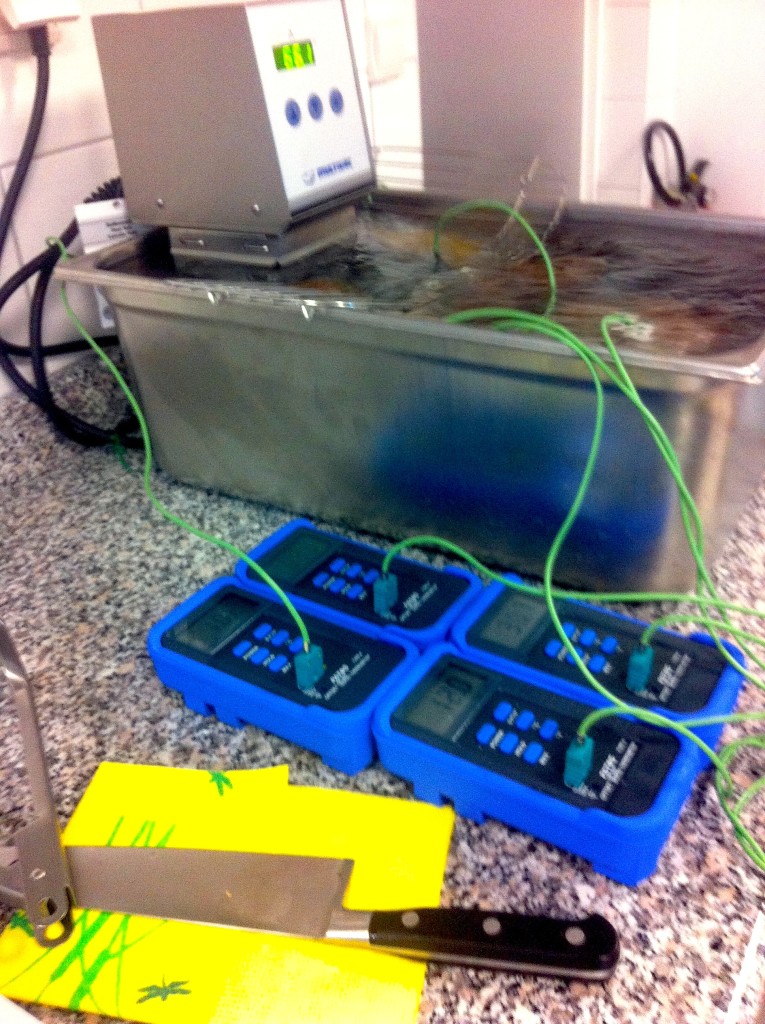When I moved to London after Le Cordon Bleu, I trialled at one of the top British restaurants. All I saw was a position by the vacuum chamber. Before they could offer me the job, I bolted. I’m glad I realised even back then, without knowing too much about sous vide cooking, that it wasn’t meant for me.
So what is sous vide cooking?
Cooking sous vide sounds fancy, but it’s much simpler than that. It literally means ‘under vacuum’. The basic premise is that food is cooked in a bag immersed in water which is maintained at a constant, precise temperature, yielding an evenly cooked dish. It is a technique used in several modern restaurants worldwide.
And how do you cook sous vide? Simply place the uncooked ingredients in food grade plastic bags, vacuum seal them, and place them in a water bath. Fit the water bath with a circulator or use a steam oven that maintains a precise temperature depending on the food you’re cooking. While cooking meat, the bag should be pierced with a fine tip thermometer held with turbigomme to keep the vacuum intact. When the food reaches the target temperature at the core, remove the bags and finish the process as the dish demands.
During my course at Alain Ducasse in France, I spent a week cooking in the premises of a large scale vacuum machine producer. My views on sous vide cooking remain unchanged. In fact, my skepticism in a cook being able to develop tactile skills through this technique is reinforced.
 I want a kitchen to feel like a kitchen, not a lab. I want to hear the steak sizzle as it hits the pan. I want to smell the chicken roast. I want to pinch the lamb racks to check for doneness instead of inserting a probe and waiting for it to beep when the temperature hits 54C. Sous vide cooking relies less on skill and more on adhering to process.
I want a kitchen to feel like a kitchen, not a lab. I want to hear the steak sizzle as it hits the pan. I want to smell the chicken roast. I want to pinch the lamb racks to check for doneness instead of inserting a probe and waiting for it to beep when the temperature hits 54C. Sous vide cooking relies less on skill and more on adhering to process.
That said, it is hard to ignore some of the practical benefits of sous vide cooking.
A highly process-oriented restaurant operation might actually find it handy. Sous vide is a useful technique for delivering consistent results when one has new or untrained cooks who can blindly execute when given water temperature, core temperature, a probe and a 5 minute explanation on using the vacuum chamber. Or perhaps even when one has to cook large quantities to save time. Given the turnover restaurants have compared to any other industry, sous vide might be a necessary evil.
Sous vide cooking can also be economical, once the initial investments are made. Sousvide reduces the loss in weight of meat as compared to traditional methods. And it’s also economical in terms of organising and planning staff, since large quantities of food can be processed in bags and forgotten about while the cook is freed to take on other tasks.
Some types of food cook better using sous vide. Meat cooked sous vide is nothing short of perfect. A colour gradient between the outer walls and middle is almost non existent – it’s evenly pink and gorgeous. Fish is perfectly flaky when cooked in a water bath and internal temperature of 52°C. When pan frying, the temperature of the pan is at least 150-200°C hotter than the ideal core temperature of the fish or meat, thus the edges will be far more cooked than the center – sous vide fixes this. Perfect eggs are also possible. While technically it’s not sous vide because there are no vacuum bags involved, holding them in a waterbath at 64°C yields the perfect soft-boiled egg.
Still, I’m not a fan.
Not everything turns out well. For instance – vegetables. Dear Lord, the vegetables. They look nothing short of hospital food. The colours are unwelcoming and the texture too uniform – that of steamed vegetables. Vegetables should never go into that water bath unless they are meant to be steamed and puréed.
It just doesn’t seem like real food. Food that’s cooked with skills and technique.
One of my chefs at school described a meal he had eaten at a Parisian gastro restaurant in Paris as ‘too uniform, too uninspiring and barely warm’. I wasn’t surprised.
During my exams last week, I decided I wouldn’t cook anything sous vide even though it would have made life easier in the stress and commotion. I am proud that all my three dishes were perfectly cooked. The red mullet, the brill and the rack of lamb (it should have rested a tad longer).The Thermapen can wait.